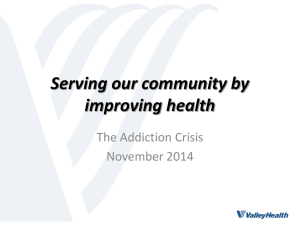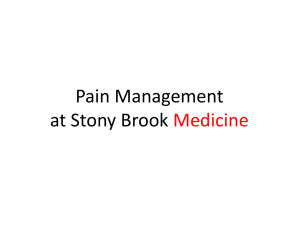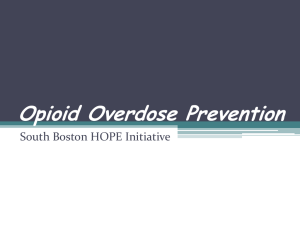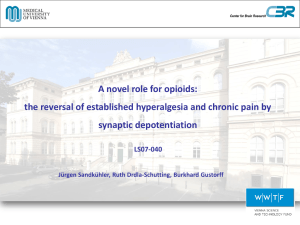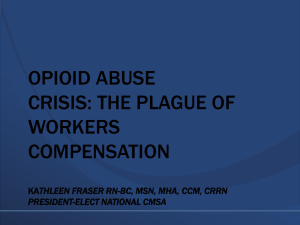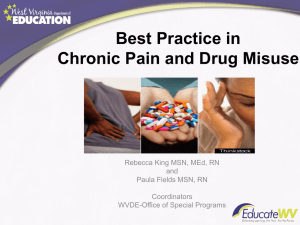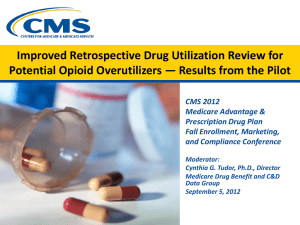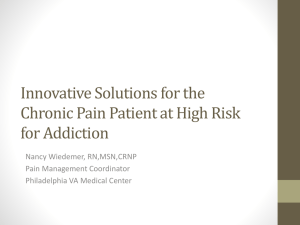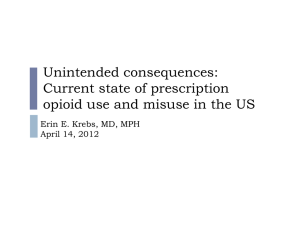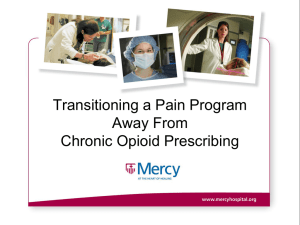Responding to the Opioid Addiction Epidemic
advertisement
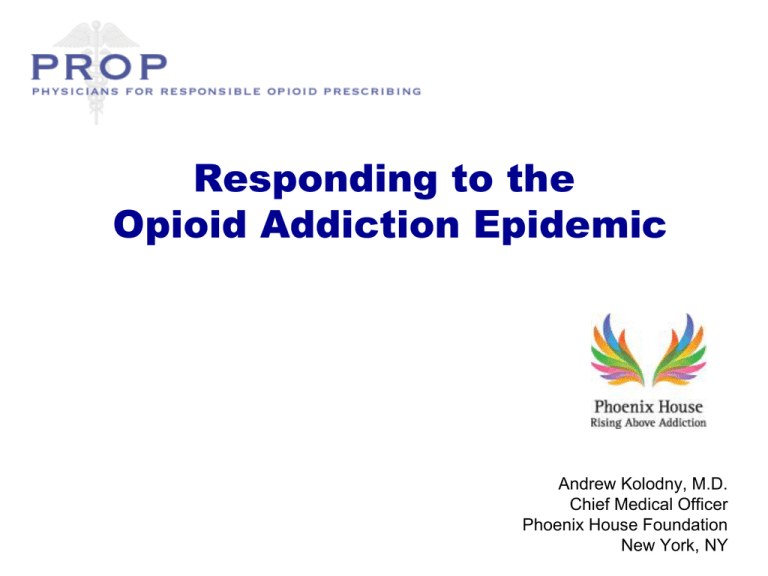
Responding to the Opioid Addiction Epidemic Andrew Kolodny, M.D. Chief Medical Officer Phoenix House Foundation New York, NY The Opium Poppy Papaver Somniferum 2 Crude Opium Latex on Poppy Head 3 Opioids • • • • • • • • Morphine Naturally occurring opioidsCodeine also called opiates Thebaine Diacetylmorphine (Heroin) Hydrocodone (Vicodin) Oxycodone (Oxycontin) Oxymorphone (Opana) Hydromorphone (Dilaudid) Semi-synthetic opioids Prior Opioid Addiction Epidemics 1. Late 1800s: Morphine • Mainly middle class • Female > Male 2. Early 1900s: Heroin (pharmaceutical grade) • First generation Italians, Jews, Irish • Male > Female 3. 1950s-1970s- Heroin (illicit) • African American/Latinos • Male > Female Governor Shumlin devotes entire state of the state speech to Vermont’s opioid addiction epidemic 6 Unintentional Drug Overdose Deaths United States, 1970–2007 10 Death rate per 100,000 9 38,329 drug overdose deaths in 2010 8 7 6 5 4 Cocaine 3 2 Heroin 1 0 '70 '72 '74 '76 '78 '80 '82 '84 '86 '88 '90 '92 '94 '96 '98 '00 '02 '04 '06 Year National Vital Statistics System, http://wonder.cdc.gov Drug Overdose Deaths by Major Drug Type, United States, 1999–2010 Opioids Heroin Cocaine Benzodiazepines 18,000 16,000 Number of Deaths 14,000 12,000 10,000 8,000 6,000 4,000 2,000 0 1999 2000 2001 2002 2003 2004 2005 2006 2007 2008 Year CDC, National Center for Health Statistics, National Vital Statistics System, CDC Wonder. Updated with 2010 mortality data. 2009 2010 Primary non-heroin opiates/synthetics admission rates, by State (per 100,000 population aged 12 and over) 9 Primary non-heroin opiates/synthetics admission rates, by State (per 100,000 population aged 12 and over) 10 Primary non-heroin opiates/synthetics admission rates, by State (per 100,000 population aged 12 and over) 11 Primary non-heroin opiates/synthetics admission rates, by State (per 100,000 population aged 12 and over) 12 Primary non-heroin opiates/synthetics admission rates, by State (per 100,000 population aged 12 and over) 13 Primary non-heroin opiates/synthetics admission rates, by State (per 100,000 population aged 12 and over) 14 Non-heroin opioid admissions, by gender, age, race/ethnicity: 2011 15 Heroin admissions, by age group & race/ethnicity: 2001- 2011 16 Unintentional overdose deaths involving opioid analgesics parallel per capita sales of opioid analgesics in morphine equivalents by year, U.S., 1997-2007 14000 * 800 12000 700 10000 600 8000 500 Number of 6000 Opioid sales (mg/person) Deaths 400 300 4000 200 2000 100 0 0 '97 '98 '99 '00 '01 '02 '03 '04 '05 Source: National Vital Statistics System, multiple cause of death dataset, and DEA ARCOS * 2007 opioid sales figure is preliminary. '06 '07 8 Rates of Opioid Sales, OD Deaths, and Treatment, 1999–2010 Opioid Sales KG/10,000 Opioid Deaths/100,000 2000 2003 Opioid Treatment Admissions/10,000 7 6 Rate 5 4 3 2 1 0 1999 CDC. MMWR 2011 2001 2002 2004 2005 Year 2006 2007 2008 2009 2010 19 20 Dollars Spent Marketing OxyContin (1996-2001) Source: United States General Accounting Office: Dec. 2003, “OxyContin Abuse and Diversion and Efforts to Address the Problem.” Industry-funded “education” emphasizes: • Opioid addiction is rare in pain patients. • Physicians are needlessly allowing patients to suffer because of “opiophobia.” • Opioids are safe and effective for chronic pain. • Opioid therapy can be easily discontinued. 22 Industry-funded organizations campaigned for greater use of opioids • Pain Patient Groups • Professional Societies • The Joint Commission • The Federation of State Medical Boards 23 “The risk of addiction is much less than 1%” Porter J, Jick H. Addiction rare in patients treated with narcotics. N Engl J Med. 1980 Jan 10;302(2):123 Cited 824 times (Google Scholar) 24 N Engl J Med. 1980 Jan 10;302(2):123. 25 “I think that after 20 years of a failed experiment that there are not many people supporting this except for the die-hards and the pharmaceutical industry.” Jane C. Ballantyne, MD FRCA Professor, Univ. of Washington Source: New York Times, April 9, 2012. “Tightening the Lid on Pain Prescriptions”. The Emperor’s New Paradigm: Patient Selection, Risk Stratification & Monitoring 28 Urine Tox Results in Chronic Pain Patients on Opioid Therapy Source: Couto JE, Goldfarb NI, Leider HL, Romney MC, Sharma S. High rates of inappropriate drug use in the chronic pain population. Popul Health Manag. 2009;12(4):185–190. 29 Controlling the epidemic: A Three-pronged Approach • Prevent new cases of opioid addiction. • Treatment for people who are already addicted • Supply control- Medical board & law enforcement efforts to reduce overprescribing and black-market availability. 30 Opioid manufacturers continue to advertise opioids as safe and effective for chronic pain. How the opioid industry Frames the Problem Source: Slide presented by Lynn R. Webster MD at FDA meeting on hydrocodone upscheduling, January 25th, 2013. Drug overdose death rates by intent by age group, US, 2008 33 This is a false dichotomy Aberrant drug use behaviors are common in pain patients 63% admitted to using opioids for purposes other than pain1 Pain Patients “Drug Abusers” 35% met DSM V criteria for addiction2 92% of opioid OD decedents were prescribed opioids for chronic pain. 1. Fleming MF, Balousek SL, Klessig CL, Mundt MP, Brown DD. Substance Use Disorders in a Primary Care Sample Receiving Daily Opioid Therapy. J Pain 2007;8:573-582. 2. Boscarino JA, Rukstalis MR, Hoffman SN, et al. Prevalence of prescription opioid-use disorder among chronic pain patients: comparison of the DSM-5 vs. DSM-4 diagnostic criteria. J Addict Dis. 2011;30:185-194. 3. Johnson EM, Lanier WA, Merrill RM, et al. Unintentional Prescription Opioid-Related Overdose Deaths: Description of Decedents by Next of Kin or Best Contact, Utah, 2008-2009. J Gen Intern Med. 2012 Oct 16. Frequently Discussed Interventions • Abuse-deterrent formulations • Expanding access to naloxone • Expanding access to medication assisted treatment • PDMP-based interventions • Mandatory prescriber education 35 Buprenorphine Treatment • Partial agonist – Weaker effects – Safer to use • Long duration of action • Milder withdrawal symptoms Full Opioid Agonists Buprenorphine- A Partial Agonist Summary • We are in the midst of the worst drug epidemic in U.S. history. • To end the epidemic we need to: – PREVENT new cases of opioid addiction – TREAT people who are already addicted 40 Please visit www.supportPROP.org @andrewkolodny 41

